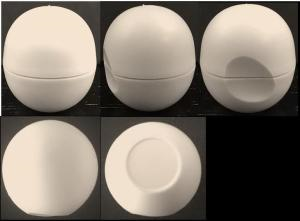The thorny issue of the registration of a 3D trade mark never ceases to challenge the trade mark system. This time it is the Court of Justice of the European Union (CJEU), which recently denied the admissibility of appeal, brought by Eos Products (more commonly known as EOS) against the decision by the General Court (case C-672/21 P). As a result, EOS did not succeed in registering the shape of its egg-shaped lip balm as a 3D trade mark.
EOS is a US-based company, identified with its colourful egg-shaped lip balms. In 2016, EOS filed an application at the EUIPO to register a 3D trade mark in black and white, depicted above, in Classes 3 (including non-medicated lip balms), 5 (including medicated lip balms), and 21 (including containers for cosmetics).
The application was objected by the examiner in respect of all the goods. The examiner was of the view that the mark lacked inherent distinctiveness pursuant to Article 7(1)(b) EUTMR. Further, the examiner opined that the 3D trade mark constituted the appearance of the product itself or of its packaging, and it did not depart significantly from other shapes of packaging for lip balms that are customary on the market (as is required for the registrability of 3D trade marks that consist of the representation of the shape of the product itself).
EOS maintained that the trade mark was inherently distinctive and, in the alternative, was registrable based on acquired distinctiveness, under Article 7(3) EUTMR. The examiner rejected EOS's application, citing insufficiency of evidence to support inherent and acquired distinctiveness.
EOS appealed to the EUIPO Boards of Appeal (case R 2017/2019-4). The Boards of Appeal (BoA), too, denied registration.
As for inherent distinctiveness, the BoA stated that round and spherical containers are common in the cosmetics market, citing examples from documents submitted by the applicant itself (para. 41-42). The BoA rejected various arguments put forth by the applicant (such as the existence of third-party product imitations, and a prior German trade mark) as irrelevant for establishing inherent distinctiveness at the EU level.
For acquired distinctiveness, the BoA first found that none of the evidence provided covered medicated products in Class 5 or containers for cosmetics in Class 21, but only concerned lip balms in Class 3. As for Class 3, the BoA was of the view that the evidence showed only lip balms in various colors (as opposed to the applicant portraying the mark black and white). Moreover, all the examples contained the letters “eos”. With regards to other evidence, EOS provided surveys (the quality of which was criticised in the decision) that since they concerned only Germany and Austria, one could not extrapolate their results to the other EU Member States. The applicant thus failed to demonstrate distinctiveness acquired through use.
EOS then appealed to the General Court (case T-489/20, available only in French and German). In the judgment, decided soon after the decision in Guerlain, the General Court mainly confirmed the findings of the EUIPO.
Notably, EOS challenged the BoA’s conclusions only on inherent distinctiveness (para. 12). Thus, the General Court focused on whether the EOS application was distinctive from the outset (saying it was not). Unlike the result in the Guerlain case, where the Court held that the shape of Guerlain’s Rouge R lipstick was distinctive, here the General Court was not convinced by the EOS arguments of “the sobriety of [the lip balm’s] spherical or ovoid shape”.
In early February, the CJEU denied the admissibility of appeal against the decision in T-489/20, thus ending the EOS trade mark battle over its egg-shaped lip balm.
For several years, distinctiveness of 3D trade marks based on shape has been in the spotlight of fashion lawyers, as seen in the previously-mentioned Guerlain case or, more recently, in the decision in Moon Boots. While certainly not a balmy day for EOS, the result seems more about unconvincing argumentation and insufficient or belated evidence, rather than anything legally inherent in the applied-for mark.
Eos fails to register the shape of its lip balm as EUTM (case C-672/21 P)
 Reviewed by Anastasiia Kyrylenko
on
Tuesday, February 22, 2022
Rating:
Reviewed by Anastasiia Kyrylenko
on
Tuesday, February 22, 2022
Rating:
 Reviewed by Anastasiia Kyrylenko
on
Tuesday, February 22, 2022
Rating:
Reviewed by Anastasiia Kyrylenko
on
Tuesday, February 22, 2022
Rating:





![[GuestPost] G1/24: Tuning in! A take on the state of proceedings before oral proceedings](https://blogger.googleusercontent.com/img/b/R29vZ2xl/AVvXsEjZhEivE5bp7QOwZsyZXAXbVNYSmLjUthkB2Q7fm1_dpB97u5lIQeyWT9ZadUTAH3Z-hXn13VpW4vBDRPx9emCnoDV6tbUTkyvfmqPv1nNInL8XMdrAtSZ2hcRQr2LjxKovC9wTk_XyZxQ0CtX1MUrO_Muz3OJ4ld8AftymsdUmKD7xNksYMwk6/s150/Picture%201.png)
![[Guest post] ‘Ghiblification’ and the Moral Wrongs of U.S. Copyright Law](https://blogger.googleusercontent.com/img/b/R29vZ2xl/AVvXsEhxl1BQBAW3Y-asjb1xXB9eA4DYy77fky6WgR-prC-_6DeBbDqOgCUDWyiz0Q3B23MWWAXnkbS2H2js7OUwA0JQXAHmsyVFgGIHeJz7zJ791vTzOD-4SJqWFIuywFXQyd3ahybbdZd4e8IEVfcNqctvyR8lumv_Gix6Tsw5cSvbHpTI1nwvztDuAQ/s150/IMG_2179.HEIC)


![[Guest book review] The Handbook of Fashion Law (with a discount code)](https://blogger.googleusercontent.com/img/b/R29vZ2xl/AVvXsEgB4h2AdqJKwq9O3Ft4Mb7C39tv_NeFpkzrOfvhIsuwAkM_ops2Hgj7fdwzq_TQsjQDvQrQa-yyC9Q9pNiugseXRlUaMdsr_cmYUbh9lH8HDECMCbsTuNboVgpafyEhkgDkVS6ruHkuz8Sx0QVGI_1S8R9kbsHdNIYrRjqhyphenhyphen010_txjJUYvlZOtWA/s150/Fashion%20Law%20Book%20Bicture.jpg)







No comments:
All comments must be moderated by a member of the IPKat team before they appear on the blog. Comments will not be allowed if the contravene the IPKat policy that readers' comments should not be obscene or defamatory; they should not consist of ad hominem attacks on members of the blog team or other comment-posters and they should make a constructive contribution to the discussion of the post on which they purport to comment.
It is also the IPKat policy that comments should not be made completely anonymously, and users should use a consistent name or pseudonym (which should not itself be defamatory or obscene, or that of another real person), either in the "identity" field, or at the beginning of the comment. Current practice is to, however, allow a limited number of comments that contravene this policy, provided that the comment has a high degree of relevance and the comment chain does not become too difficult to follow.
Learn more here: http://ipkitten.blogspot.com/p/want-to-complain.html